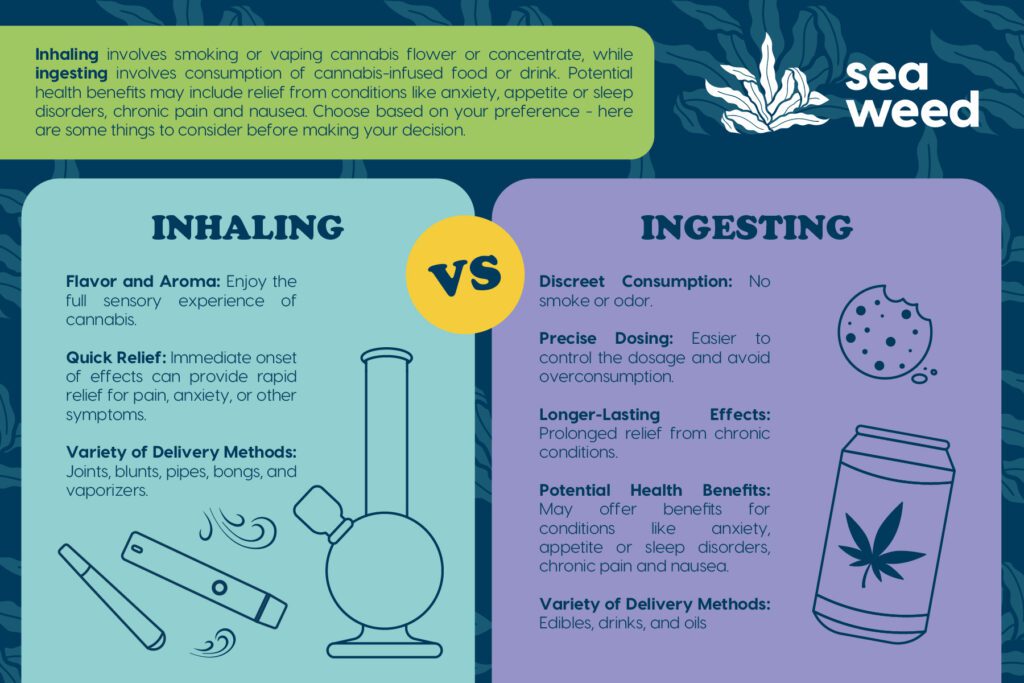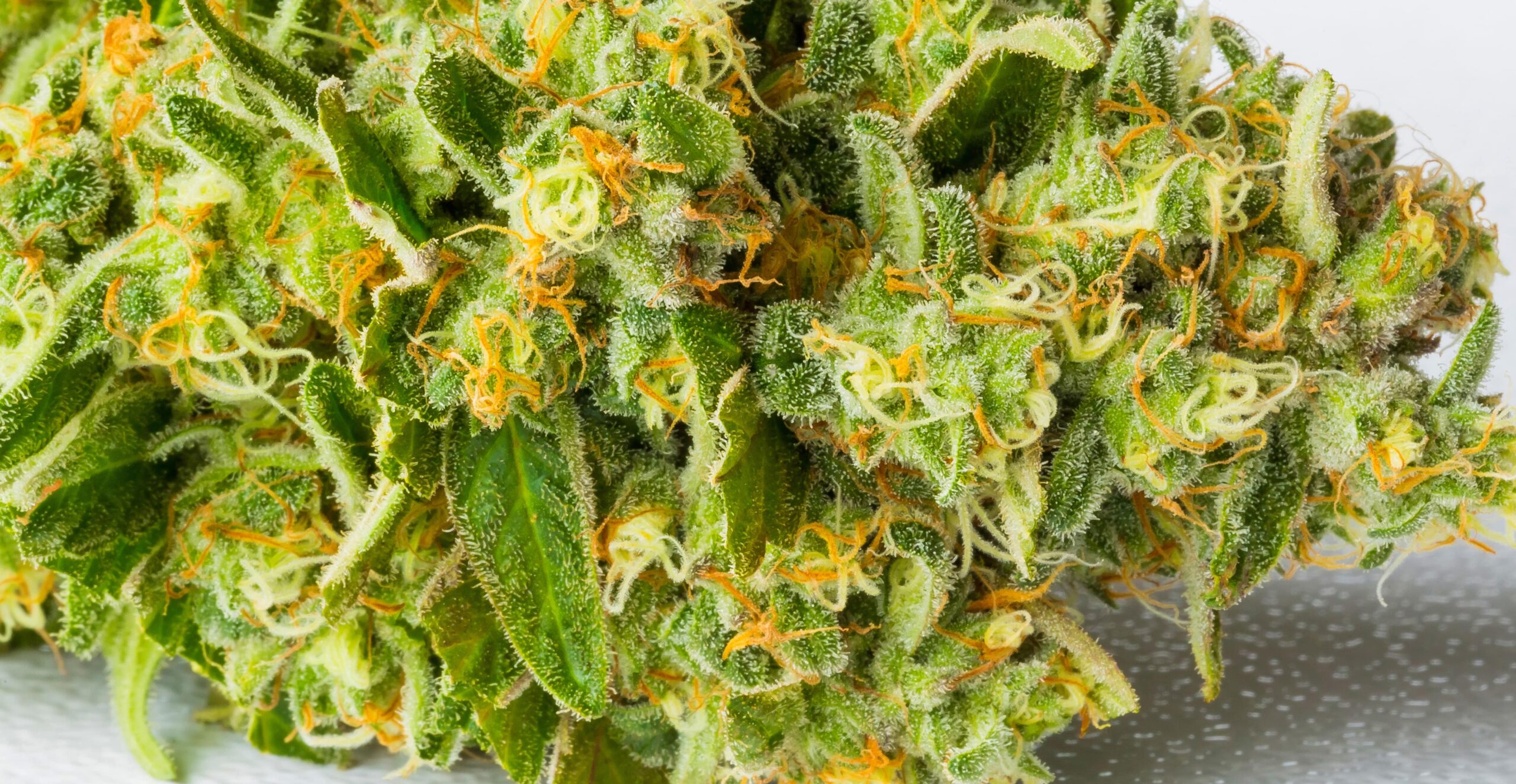Choose Your Cannabis Journey
Cannabis offers different ways to shape your experience. Whether you prefer THC or CBD, smoking a joint or a bowl, or eating an edible, cannabis consumption offers a diverse range of methods to match individual preferences and effects. When it comes to choosing between smoking vs. edibles, smoking, through joints, pipes, or vaporizers, can provide almost immediate effects. In contrast, edibles—cannabis-infused foods or drinks—require digestion, leading to a slower onset but often a more potent and long-lasting experience.
The choice of method shapes the duration, intensity, and overall experience. These differences make selecting a method an important decision tailored to the individual’s tolerance and the desired effects.
In this blog, explore the pros and cons of smoking versus edibles to determine which route you prefer.

The Basics – What’s the Difference Between Smoking and Edibles?
Smoking
Ways to smoke
Smoking cannabis, or “toking,” involves inhaling cannabinoids through methods like joints (hand-rolled cannabis cigarettes), blunts (rolled in tobacco leaf wrappers), or pipes, bowls, or bongs.
What to expect
This method delivers fast-acting effects as cannabinoids start to absorb through the lungs. You can begin to feel effects almost immediately, and the effects last 1–3 hours. It’s a go-to choice for those seeking quick, controllable experiences.
Edibles
Ways to ingest
Edibles, like brownies or gummies, offer a smoke-free alternative with a longer-lasting impact. These cannabis-infused treats must be digested and metabolized by the liver, taking 30 minutes to 2 hours to kick in.
What to expect
While the effects can be slower, they’re often stronger and can last 4–8 hours, making edibles ideal for those seeking a discreet and sustained experience.
Duration and Intensity: What Lasts Longer, Smoking or Edibles?
Pros and Cons of Smoking vs. Edibles
When choosing between smoking and edibles, it’s essential to consider how these methods differ in onset time, duration, health impact, and overall experience.
Smoking
- Pros:
- Immediate effects: You can feel the effects nearly instantly, making it easy to gauge dosage.
- Social appeal: Smoking is often viewed as a communal activity, enhancing social interactions.
- Customizable dosage: Users can take smaller puffs to fine-tune their experience.
- Cons:
- Health risks: Inhaling smoke can irritate the lungs.
- Shorter duration: Effects wear off in less time.
- Less discreet: May smell or be more noticeable.
Edibles
- Pros:
- Longer-lasting effects: Effects can last longer, providing sustained relief.
- Smoke-free: A healthier option for those concerned about respiratory health.
- Discreet consumption: Edibles are odorless and easy to consume in public or private.
- Cons:
- Delayed onset: Effects take longer to kick in, making it harder to gauge dosage.
- Risk of overconsumption: The delayed effects may lead to taking too much before you feel the initial dose.
- Less social: Edibles are less social since they lack the communal ritual of smoking.
Smoking is often preferred for social situations or quick relaxation, offering immediate effects that allow users to control their dosage with ease. However, edibles are favored for extended relief, making them ideal for managing chronic pain or achieving prolonged effects. They are also a discreet, smoke-free option.
The way terpenes behave in edibles versus smoking or vaping differs significantly, primarily due to the method of consumption and how heat affects these compounds. Here’s a breakdown:
Terpenes in Smoking/Vaping
- Retention and Activation: Terpenes can be activated and released at specific temperatures when smoking or vaping, providing distinct flavors, aromas, and effects.
- Rapid Absorption: When inhaled, terpenes interact with cannabinoids (e.g., THC and CBD) almost immediately, influencing the experience (e.g., relaxation, focus).
- Degradation: High temperatures (above ~300°F or 150°C) can degrade terpenes, altering their effects or potentially destroying them.
Terpenes in Edibles
- Heat Degradation During Cooking: Compared to smoking or vaping, terpenes can fade and lose concentration during the cooking or decarboxylation process used to make edibles.
- Delayed Onset: Since edibles process through digestion, terpenes take longer to produce effects and may contribute less strongly to immediate outcomes than inhalation.
- Metabolism Impact: As the liver metabolizes edibles, the effects of terpenes may differ from inhalation, with their influence potentially diminished.
Key Differences
| Aspect | Smoking/Vaping | Edibles |
| Terpene Retention | Higher (if temperatures are controlled) | Lower (lost during cooking/extraction) |
| Onset of Effects | Immediate | Delayed (digestion-dependent) |
| Flavor and Aroma | Strong and noticeable | Subtle or muted |
| Effects | More pronounced due to rapid absorption | Less direct influence on effects |
In edibles, the effects are primarily driven by cannabinoids rather than terpenes, but some high-quality edibles may include additional terpene profiles to enhance the experience.
Learn more about the different terpenes by checking out our other blog.
Dosing Differences: How Much Edible Equals a Joint?
Dosing cannabis can vary significantly between edibles and smoking due to differences in absorption, potency, and individual tolerance.
Smoking allows users to take small, incremental doses, often referred to as “microdosing,” with effects felt almost immediately. This instant feedback makes it easier to find an effective dose without overconsuming. A single puff is often sufficient for beginners, who can gradually increase their intake based on their feelings.
Edibles, however, are more complex to dose accurately, especially for new users. The effects take longer to kick in—typically 30 minutes to 2 hours—making it easier to accidentally overconsume while waiting for the initial dose to take effect. Beginners should start with a low dose, such as 2.5–5 mg of THC, and wait at least two hours before considering another dose.
Because edibles are metabolized differently, their effects are usually more potent and longer-lasting compared to smoking. Understanding equivalent doses can help, but users should start small and proceed cautiously with edibles to avoid an overwhelming experience.
Which Method Is Right for You? Making a Choice Based on Your Needs
When choosing cannabis, the method of consumption significantly impacts the experience. For smoking or vaping, Indica strains are ideal for relaxation or sleep, while Sativa strains are better suited for energy and focus, as their effects tend to be more distinct.
However, in edibles, the focus should shift to THC/CBD content and dosing rather than the Indica or Sativa label, as the strain-specific effects are less pronounced. This is mainly due to the loss of terpenes during the cooking and extraction process, which diminishes the unique characteristics of each strain. Additionally, the dose of THC or CBD in edibles plays a more significant role in shaping the experience than the strain itself.
To make your decision, you should consider your lifestyle, health priorities, and experience level with cannabis. If you’re seeking immediate effects or prefer a method that allows precise control over your dose, smoking may be the better choice. It’s ideal for social settings or quick relaxation and suits those who don’t mind the act of smoking or its potential respiratory risks. Edibles may be better for users seeking long-lasting effects, such as managing chronic pain or ensuring sustained relaxation.
Starting low and slow is critical for beginners, regardless of the method. New users might find smoking easier to control, as the effects are immediate and fade relatively quickly, allowing for better dosage adjustments. Edibles require patience due to their delayed onset, and users should carefully measure their intake to avoid overconsumption.
Experienced users can choose based on their needs or settings, balancing convenience, duration, and intensity. Understanding the pros and cons of each method helps you make an informed choice, ensuring a safe and enjoyable cannabis experience tailored to your goals.
Tips for Beginners
Smoking vs. Edibles: What’s Better for Beginners?
- Onset Time: Smoking provides almost immediate effects, allowing beginners to gauge their tolerance in real time and adjust their intake accordingly. Edibles take 30 minutes to 2 hours to kick in, which can lead to accidental overconsumption if patience isn’t exercised.
- Control and Dosing: Smoking offers more control, as you can take one puff, wait, and decide whether to continue. With edibles, start with a low dose (2.5–5 mg of THC) and wait at least 2 hours before considering more. For beginners, the delayed onset of edibles can make them tricky to navigate without proper caution.
- Duration of Effects: The effects of smoking are shorter, typically lasting 2–3 hours, making it easier for beginners to manage. Edibles last much longer, often 4–8 hours, which might feel overwhelming for someone new to cannabis.
- Ease of Use: Smoking requires some preparation, like rolling a joint or using a pipe, and may produce a noticeable odor. Edibles are discreet and portable but require careful reading of labels to avoid overconsumption.
Smoking vs. Edibles – The Final Puff or Bite, You Decide!
Cannabis consumption offers various methods to suit individual needs and preferences. Smoking provides fast, controllable effects, ideal for social settings or quick relief, while edibles deliver longer-lasting, potent effects, perfect for managing pain or achieving sustained relaxation. Smoking offers immediacy but carries respiratory risks, while edibles are discreet and smoke-free, they require patience due to their delayed onset.
Choosing the best method depends on lifestyle, health goals, and experience level. Smoking may be easier for beginners to control, while edibles are better for long-term relief or avoiding smoke-related risks. Understanding onset, duration, and dosing ensures a safe and enjoyable experience tailored to your goals.
If you still need help deciding, stop by Seaweed and consult with one of our expert budtenders. Our team is there to help answer any of your questions and assist you in your cannabis journey.










